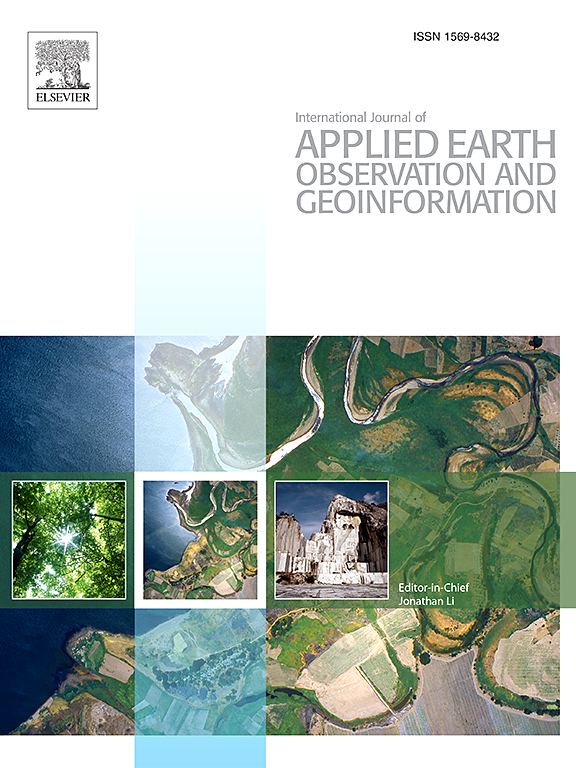Estimating water levels in reservoirs using Sentinel-2 derived time series of surface water areas: A case study of 20 reservoirs in Burkina Faso
IF 7.6
Q1 REMOTE SENSING
International journal of applied earth observation and geoinformation : ITC journal
Pub Date : 2025-04-11
DOI:10.1016/j.jag.2025.104523
引用次数: 0
Abstract
Reservoirs play a significant role in the mobilization of water resources in Burkina Faso, contributing to the management and availability of water for various purposes. Operational management of reservoirs requires accurate and timely water level information, which remote sensing can provide cost-effectively and with limited resources. In this study, the surface area of 20 reservoirs is first determined using a Random Forest classifier and Sentinel-2 images acquired between 2015 and 2022. The accuracy of the classified surface water areas is evaluated by calculating 5 accuracy assessment metrics. The classifications were validated using manually digitized water areas from high-resolution Google Earth images and compared to the Dynamic World (DW) land cover dataset. Afterward, the spatial variation in the areal extent of the reservoirs is analyzed over time. A linear relationship is established between the estimated surface area and the corresponding observed water level of the reservoirs. The results indicate that reservoir surface areas were accurately classified with Sentinel-2 images (Kappa above 90.35%) for all dates. Moreover, validation with high-resolution images provided an of 0.99 and a Normalized Root Mean Square Error (NRMSE) of 3.53%. Smaller reservoirs exhibit significant variations in surface areas over time as compared to larger ones, which are more stable. The relationship between surface area and water level is satisfactory ( ranging from 0.76 to 0.97) for 14 of the 20 analyzed reservoirs. The remaining six reservoirs are affected by aquatic plant intrusion which leads to an underestimation of the surface area. The high accuracy and operational feasibility of the proposed approach demonstrate that Sentinel-2 imagery and machine learning techniques can be recommended for reservoir mapping within the framework of water level monitoring in Burkina Faso.
利用Sentinel-2衍生的地表水区域时间序列估算水库水位:以布基纳法索20个水库为例研究
水库在布基纳法索调动水资源方面发挥着重要作用,有助于各种用途的水的管理和供应。水库的运行管理需要准确、及时的水位信息,而遥感可以在资源有限的情况下经济有效地提供这些信息。在这项研究中,首先使用随机森林分类器和2015年至2022年间获取的Sentinel-2图像确定了20个水库的表面积。通过计算5个精度评价指标,对地表水分类的精度进行了评价。使用高分辨率谷歌地球图像的人工数字化水域进行分类验证,并与动态世界(DW)土地覆盖数据集进行比较。然后,分析了储层面积范围随时间的空间变化规律。在水库的估算表面积和相应的观测水位之间建立了线性关系。结果表明,Sentinel-2遥感影像(Kappa值在90.35%以上)对水库地表进行了准确分类。此外,高分辨率图像验证的R2为0.99,标准化均方根误差(NRMSE)为3.53%。与较大的储层相比,较小的储层的表面积随时间的变化较大,而较大的储层则更稳定。20个水库中有14个水库的表面积与水位的关系较好(R2在0.76 ~ 0.97之间)。其余6个水库受到水生植物入侵的影响,导致对水面面积的低估。所提出方法的高精度和操作可行性表明,Sentinel-2图像和机器学习技术可以推荐用于布基纳法索水位监测框架内的水库测绘。
本文章由计算机程序翻译,如有差异,请以英文原文为准。
求助全文
约1分钟内获得全文
求助全文
来源期刊

International journal of applied earth observation and geoinformation : ITC journal
Global and Planetary Change, Management, Monitoring, Policy and Law, Earth-Surface Processes, Computers in Earth Sciences
CiteScore
12.00
自引率
0.00%
发文量
0
审稿时长
77 days
期刊介绍:
The International Journal of Applied Earth Observation and Geoinformation publishes original papers that utilize earth observation data for natural resource and environmental inventory and management. These data primarily originate from remote sensing platforms, including satellites and aircraft, supplemented by surface and subsurface measurements. Addressing natural resources such as forests, agricultural land, soils, and water, as well as environmental concerns like biodiversity, land degradation, and hazards, the journal explores conceptual and data-driven approaches. It covers geoinformation themes like capturing, databasing, visualization, interpretation, data quality, and spatial uncertainty.
 求助内容:
求助内容: 应助结果提醒方式:
应助结果提醒方式:


